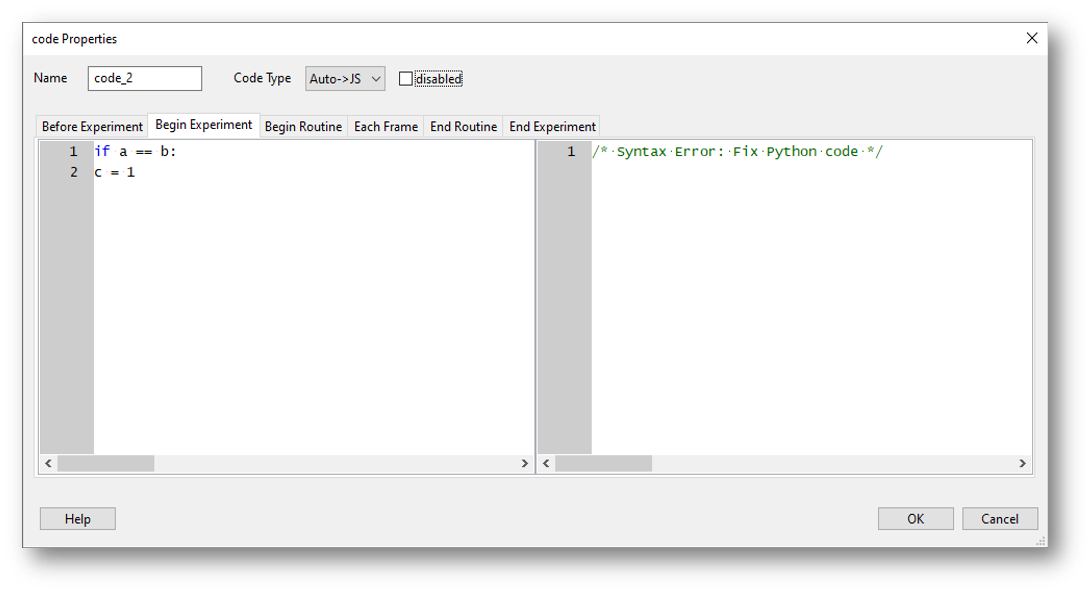
Add the names of the image files you want to show to these columns and make sure that values in the stimFormat column match the format (.png.
#VISUAL TASK PSYCHOPY EXAMPLE CODE TRIAL#
Once uploaded, you can access them using the stim (stim1, stim2, stim3 etc.) columns of the trial file. You can upload your own, custom stimuli to the stimuli library of your Testable project. Here are a few examples of changes you might want to make to the Flanker Task: Once you have made your changes, you can save and upload the modified trial file to your experiment’s trial file section. To change any part of your experiment, you only need to change the values in the trial file. The trial file contains all information that Testable needs to run the experiment in a simple spreadsheet, that you can edit with any spreadsheet editor you like, such as Google Sheets, Excel or Testable’s in-built preview editor. The heart of each experiment is what we call the trial file.
#VISUAL TASK PSYCHOPY EXAMPLE CODE HOW TO#
How to customise key parameters and play around with different optionsĮxperiments in Testable are fully customisable and you will not need to write a single line of code to edit them. Experiments in Testable will run in every browser, which makes it very easy to collect data both in the lab as well as online. It is set up and ready to go and you can start collecting data straight away by sending the experiment link to your participants after importing it to your projects. We have created a template for a typical Flanker task in Testable that you can access from our Library. Run this experiment in Testable from our ready-made template This is an illustration of the various stimuli setups in the flanker task

Any target colour flanked by grey boxes would be a neutral trial. Example: In the colour version, grey is not associated with any response and is never the target. Neutral trials: There can also be neutral trials, where the distracting stimuli are not paired with any response.Example: In the arrow version, a central arrow pointing to the left flanked by arrows pointing to the right is an incongruent trial. Incongruent trials: The target stimulus and distracting stimuli are associated with different responses.Example: C flanked by S in the letter version is a congruent trial, as both letters need to be responded to with the same key on the keyboard (0) Congruent trials: The target stimulus and distracting stimuli are associated with the same response.The key manipulation in any Flanker task is the congruency of target stimulus and its flankers: In our demo template you can find implementations for three versions with which you can experiment. For colour or letter versions you might instead allow the 0 and 1 keys, as they lie comfortably on either side of the keyboard. For a Flanker task with arrow stimuli it makes sense to allow responses with the left and right arrow keys. Stimuli in Flanker tasks are typically composed of a target image in the center which is flanked by one or more distractor stimuli on either side.ĭepending on the version of the task you are using, a different response might more sense. In each trial, the stimulus is shown for unlimited time until the participant responds to advance to the next trial. The setup for the Flanker task is straightforward. You can use the Eriksen Flanker task to measure the ability to suppress tempting, but irrelevant responses in a particular context. This step of choosing an appropriate action based on what we see occurs after we process our visual scene.

This shows that it takes effort to select between the competing responses elicited by the target and misleading distractors. This delay is also longer than when adding distractors that evoke no response, but make the target harder to recognise. For example, it is more difficult to match the direction of an arrow on screen by pressing the respective arrow key on your keyboard, when the surrounding arrows point in the opposite direction. The main effect demonstrated by the Flanker task is that participants take longer to respond to a target stimulus if it is ‘flanked’ by distractor stimuli that suggest a different response. The Flanker task was originally described by Eriksen & Eriksen (1974) as a test of participants’ ability to inhibit conflicting but irrelevant information using a simple experimental paradigm. What is the Flanker task is and how can you use it in your own research? Use the Flanker task template → Try the demo


 0 kommentar(er)
0 kommentar(er)
